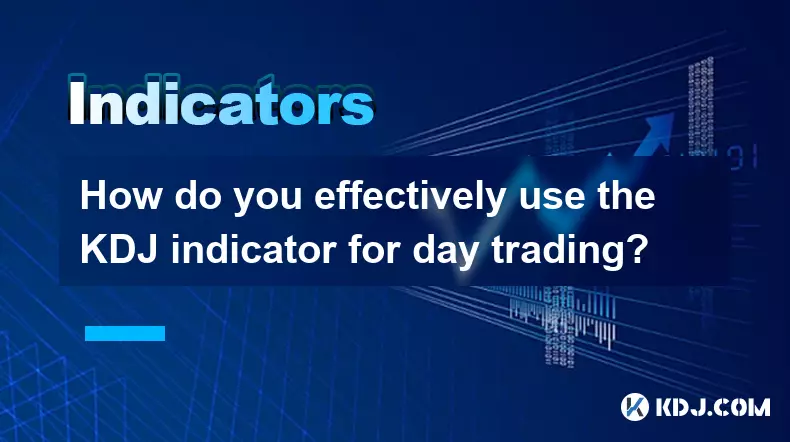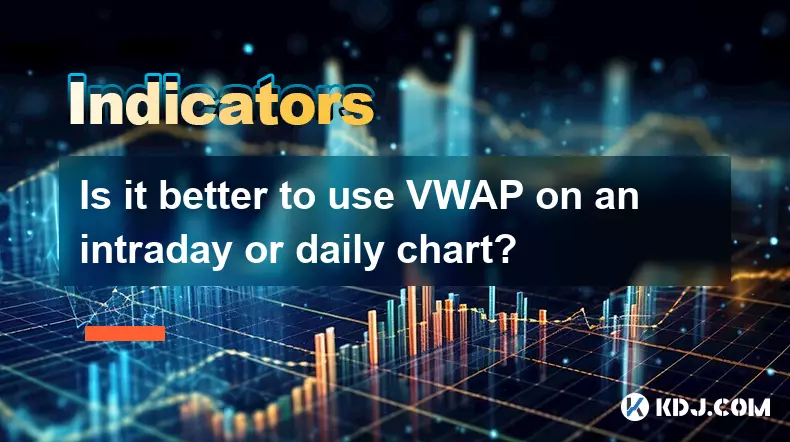-
 bitcoin
bitcoin $110918.433029 USD
-1.69% -
 ethereum
ethereum $3996.872473 USD
-2.43% -
 tether
tether $1.000594 USD
0.00% -
 bnb
bnb $1178.871834 USD
-2.38% -
 xrp
xrp $2.413973 USD
-3.47% -
 solana
solana $194.341461 USD
-4.24% -
 usd-coin
usd-coin $0.999963 USD
-0.03% -
 tron
tron $0.320092 USD
0.92% -
 dogecoin
dogecoin $0.196919 USD
-3.42% -
 cardano
cardano $0.669585 USD
-3.63% -
 hyperliquid
hyperliquid $37.485952 USD
-3.58% -
 ethena-usde
ethena-usde $1.000026 USD
-0.02% -
 chainlink
chainlink $18.018220 USD
-5.13% -
 bitcoin-cash
bitcoin-cash $523.879267 USD
-2.41% -
 stellar
stellar $0.324655 USD
-3.67%
How do you effectively use the KDJ indicator for day trading?
The KDJ indicator uses %K, %D, and %J lines to spot overbought/oversold levels and crossovers, helping day traders time entries and exits in volatile crypto markets.
Oct 16, 2025 at 09:18 am

Understanding the KDJ Indicator Components
1. The KDJ indicator is composed of three lines: %K, %D, and %J. These lines are derived from price momentum and help traders identify potential overbought or oversold market conditions in cryptocurrency assets.
2. The %K line represents the current closing price relative to the high-low range over a specified period, typically 9 periods. It reacts quickly to price changes and forms the basis for the other two lines.
3. The %D line is a moving average of %K, usually calculated over 3 periods. It acts as a signal line, smoothing out fluctuations and providing clearer trade signals.
4. The %J line is calculated as 3 times %K minus 2 times %D. This line is more volatile and often used to detect early trend reversals or divergences.
Identifying Overbought and Oversold Conditions
1. In day trading cryptocurrencies, values above 80 on the %K or %D lines generally indicate overbought conditions. This suggests that an asset may be due for a pullback or correction.
2. Readings below 20 signal oversold levels, which can present buying opportunities, especially when confirmed by volume spikes or candlestick patterns.
3. Traders should avoid entering long positions solely based on oversold readings during strong downtrends, as prices can remain oversold for extended periods.
4. Conversely, shorting purely because of overbought signals in a bullish market can lead to losses, as momentum may carry prices higher despite technical extremes.
5. Divergence between price action and the KDJ lines adds strength to reversal signals. For example, if price makes a new high but the %K line fails to surpass its previous peak, bearish divergence occurs.
Generating Entry and Exit Signals
1. A common strategy involves watching for crossovers between the %K and %D lines. When %K crosses above %D in the oversold zone, it may signal a buy opportunity.
2. Similarly, when %K crosses below %D in the overbought region, it could indicate a short entry or exit point for long positions.
3. The %J line crossing above 100 or dropping below 0 is often interpreted as an extreme condition, potentially foreshadowing a sharp reversal in BTC or altcoin prices.
4. Day traders frequently combine these crossovers with support/resistance levels or moving averages to filter false signals generated in choppy markets.
5. Exits can be timed when the %K line re-enters neutral territory (between 20 and 80) after reaching extreme zones, locking in profits before momentum fades.
Optimizing KDJ Settings for Crypto Volatility
1. Standard settings (9,3,3) may generate too many false signals in highly volatile crypto markets. Adjusting the period length can improve accuracy.
2. Shorter periods like (5,3,3) increase sensitivity, useful for scalping on 5-minute or 15-minute charts.
3. Longer periods such as (14,3,3) reduce noise and are better suited for swing-style day trades on hourly timeframes.
4. Backtesting different configurations on historical data for specific coins like ETH or SOL helps determine optimal parameters tailored to individual asset behavior.
5. Combining the adjusted KDJ with volume indicators or RSI improves reliability, reducing whipsaws during low-liquidity periods or news-driven spikes.
Frequently Asked Questions
What timeframes work best with the KDJ for crypto day trading? The 15-minute and 1-hour charts are widely used. Shorter intervals like 5 minutes suit aggressive scalpers, while 4-hour charts help confirm intraday trends.
Can the KDJ be used during major news events in the crypto space? Its effectiveness diminishes during sudden macroeconomic announcements or exchange outages. Price movements become erratic, leading to misleading crossovers and false divergences.
How does the KDJ differ from the Stochastic Oscillator? The KDJ includes the %J line, which amplifies volatility and provides earlier signals compared to the traditional Stochastic, which only uses %K and %D.
Is the KDJ reliable for low-cap altcoins? It can be less reliable due to thin order books and pump-and-dump schemes. High volatility often triggers premature signals, requiring additional confirmation tools like order flow analysis.
Disclaimer:info@kdj.com
The information provided is not trading advice. kdj.com does not assume any responsibility for any investments made based on the information provided in this article. Cryptocurrencies are highly volatile and it is highly recommended that you invest with caution after thorough research!
If you believe that the content used on this website infringes your copyright, please contact us immediately (info@kdj.com) and we will delete it promptly.
- Cryptos in Flux: MoonBull's Lunar Stampede, Solana's Struggle, and XRP's ETF Hopes
- 2025-10-17 06:25:11
- Cardone Capital Dives Deeper: Why Grant Cardone is Buying More Bitcoin Now
- 2025-10-17 06:25:11
- Decoding the Digital Horizon: Innovation, Regulation, and the Future of Crypto and Energy
- 2025-10-17 06:45:16
- Uniswap's Crossroads: Open Interest Dives Amid Volume Decline – What's Next?
- 2025-10-17 06:45:16
- Gold vs. Bitcoin: Navigating Market Volatility Like a New Yorker
- 2025-10-17 06:30:02
- Pump, Coin, Buyback: Riding the Crypto Rollercoaster, NYC Style
- 2025-10-17 06:50:01
Related knowledge

What's the main difference between VWAP and TWAP?
Oct 12,2025 at 11:54am
Understanding VWAP and Its Role in Crypto Trading1. Volume Weighted Average Price (VWAP) is a trading benchmark that calculates the average price of a...

How do you identify exhaustion moves using VWAP and its bands?
Oct 12,2025 at 08:00am
Understanding the Role of Decentralized Exchanges in Crypto Trading1. Decentralized exchanges (DEXs) operate without a central authority, allowing use...

Is it better to use VWAP on an intraday or daily chart?
Oct 15,2025 at 02:01am
Intraday Trading and the Role of VWAP1. Intraday traders frequently rely on VWAP (Volume Weighted Average Price) as a dynamic benchmark for assessing ...

How do you use VWAP to scale in and out of positions?
Oct 14,2025 at 02:19am
Understanding VWAP as a Dynamic Benchmark1. The Volume Weighted Average Price (VWAP) is not just an indicator—it functions as a dynamic benchmark that...

What are the main advantages of using VWAP over EMA?
Oct 11,2025 at 02:18am
Main Advantages of Using VWAP Over EMA1. Volume-Weighted Average Price (VWAP) incorporates trading volume into its calculation, offering a more accura...

How do you use VWAP on different chart types like Heikin Ashi?
Oct 11,2025 at 05:01pm
Understanding VWAP in the Context of Heikin Ashi Charts1. The Volume Weighted Average Price (VWAP) is a powerful analytical tool commonly used by trad...

What's the main difference between VWAP and TWAP?
Oct 12,2025 at 11:54am
Understanding VWAP and Its Role in Crypto Trading1. Volume Weighted Average Price (VWAP) is a trading benchmark that calculates the average price of a...

How do you identify exhaustion moves using VWAP and its bands?
Oct 12,2025 at 08:00am
Understanding the Role of Decentralized Exchanges in Crypto Trading1. Decentralized exchanges (DEXs) operate without a central authority, allowing use...

Is it better to use VWAP on an intraday or daily chart?
Oct 15,2025 at 02:01am
Intraday Trading and the Role of VWAP1. Intraday traders frequently rely on VWAP (Volume Weighted Average Price) as a dynamic benchmark for assessing ...

How do you use VWAP to scale in and out of positions?
Oct 14,2025 at 02:19am
Understanding VWAP as a Dynamic Benchmark1. The Volume Weighted Average Price (VWAP) is not just an indicator—it functions as a dynamic benchmark that...

What are the main advantages of using VWAP over EMA?
Oct 11,2025 at 02:18am
Main Advantages of Using VWAP Over EMA1. Volume-Weighted Average Price (VWAP) incorporates trading volume into its calculation, offering a more accura...

How do you use VWAP on different chart types like Heikin Ashi?
Oct 11,2025 at 05:01pm
Understanding VWAP in the Context of Heikin Ashi Charts1. The Volume Weighted Average Price (VWAP) is a powerful analytical tool commonly used by trad...
See all articles










































































